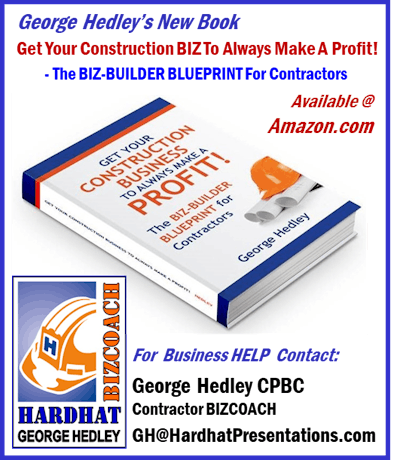
Construction business owners often ask me: “How much gross or net profit should I expect to make? - 5 percent, 10 percent, 15 percent or more?" Most don’t know how much money they should make and don’t have a specific profit target to shoot for. Some have heard 15 percent is a good target to aim at but they aren’t sure if 15 percent is net or gross. Most claim their profit goal is to make as much money as possible or to make more than they are currently making.
As Much Money As Possible! Is this a target? More! More than what? These are not clear targets or goals. A young steel contractor came to me for advice. He told me his five year goal was to work real hard, be totally stressed out, hopelessly in debt, and make no money; and he made it! I am not impressed with people who are busy, overworked, underpaid or boast about their latest sales figures while they try and make as much money as the market will allow. What I admire are organized companies that have clear annual gross and net profit targets, hit these goals and make the expected return and profit for the risk they take.
Regardless of the economy, the goal in business is not to stay in business, keep your crews busy and make as much money as possible. The goal of your business is to always make a profit. Unfortunately, 92 percent of all business owners reach age 65 with little or no net worth. It's not how much you make that matters, it's how much you keep (after overhead, job costs, personnel and a fair salary for the owner). And then it’s how much your money makes.
Profitable construction company owners have a vision of what they want. They have written goals in many areas including: business, customers, operations, financial, personal and profit. They have precise annual goals including:
- Revenue
- Gross Profit
- Overhead
- Net Profit
- Return On Equity
- Average Mark-Up
Return on equity
If asked to invest $100,000 in a friend's new start-up steel construction business, what return would you want -10 percent, 15 percent, 25 percent, 50 percent or more? After considering all the risks, I would never invest in a new construction business that didn't offer at least a conservative 15 percent minimum to 25 percent return on equity. Likewise, the minimum pre-tax net profit goal for your company should be 15 to 25 percent return on equity (or higher). Equity is the net worth or value of your company. Calculate your equity by adding up all the value of your company assets including capital, equipment, cash and receivables. Then subtract all of your liabilities including payables, loans and total debt.
To always make a profit, follow this formula:
Return On Equity Example
1. Equity In Company $ 400,000
2. Annual Return On Equity Goal X 25%
3. Annual Net Profit Goal (Pre-Tax) = $ 100,000
4. Annual Overhead Expenses + $ 500,000
5. Annual Projected Gross OH + Profit = $ 600,000
6. Average OH + P Mark-Up 30%
7. Average Gross Margin OH & P Profit _ 23%
8. Annual Sales Revenue Required (5 / 7) $ 2,608,695
Looking at the example above, this construction company's overhead is projected at $500,000, equity is $400,000 and its' return on equity goal is 25 percent. Based on the competition and marketplace, in this example the company can generate a 30 percent markup which converts to a 23 percent gross profit percentage. This will require the company to do $2,608,695 in annual sales to make it’s goal of $100,000 in net profit. The $100,000 is a fixed number. Not more! Not as much as possible!
Return on overhead
An easier way to calculate your company sales and profit goals is to use the ‘Return On Overhead’ (ROOH) method. Like investing in equity in the previous example, construction company owners also invest in overhead to build and run their businesses. Likewise, they also should get a return on their overhead cost. The average ROOH for contractors is 20 to 40 percent ROOH for subcontractors and 25 to 50 percent ROOH for general contractors.
Return On Overhead Example
1. Annual Overhead $ 500,000
2. Annual Return On Overhead Goal X 40%
3. Annual Net Profit Goal (Pre-Tax) = $ 200,000
4. Annual Overhead Expenses + $ 500,000
5. Annual Projected Gross Profit = $ 700,000
6. Average OH + P Mark-Up 30%
7. Average Gross Margin OH & P Profit _ 23%
8. Annual Sales Revenue Required (5 / 7) $ 3,043,478
In this example, the company will hit its’ overhead and profit goal if it averages 30 percent mark-up and does $3,043,478 in sales revenue.
Do you have overhead & profit goals?
- What’s your net profit goal?
- What’s your overhead goal?
- What’s your gross profit goal?
- What’s your average markup?
- What’s your revenue goal?
Companies without precise profit goals never make enough money and often don't make anything. It's hard to hit a fuzzy target that doesn't exist and moves around. Companies that track costs, target profit, control overhead and watch what they keep are in-control, organized and one-step ahead of their competition.
George Hedley works with contractors to





























